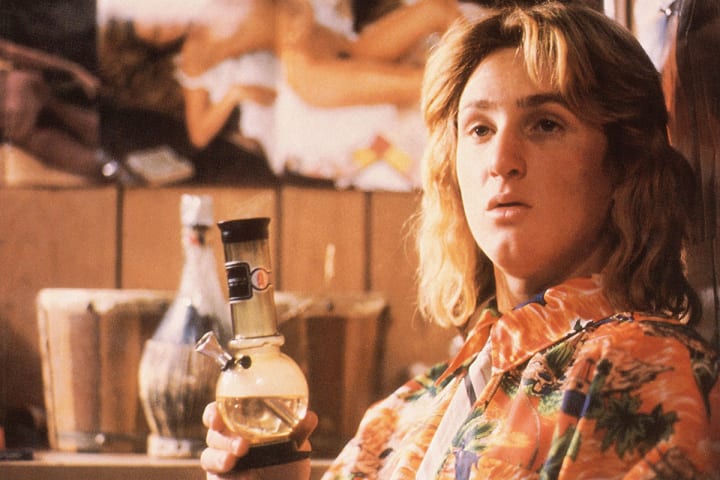
In past decades, little was known about marijuana. Those in charge believed the mysterious grass was dangerous and its effects were strictly harmful on the human body. Back in the 80s, there was a case of an honors high school student from Chicago. Three years later he was a twenty-one-year-old dropout wandering around the country. He was later committed to a sanitarium—a shell of what he once was, unable to function in the world outside his hospital window.
Was this unfortunate young man a victim of some degenerative disease or a casualty of some hallucinogenic drug such as LSD?
No. He was a heavy user of grass, suffering from “marijuana burnout”—or, technically, amotivational syndrome—and there's nothing medical science could do to cure or prevent the phenomenon. In 2016 they give awards to the best burnout YouTube channel, but back in 1984, the world didn't know what a millennial was, and marijuana hippies were still your best source for weed. There were no delivery apps in the 80s. A burnout was a social epidemic waiting to happen.
Welcome to 1984
“I saw him recently,” says Dr. Harold Voth of the world-renowned Menninger Foundation, a psychiatric clinic in Topeka, Kansas. Menninger was one of the few groups in those days progressively studying the effect marijuana had on the brain and personality. Voth had treated the tragically young casualty of marijuana burnout. “[He was] totally flat–he appears dull, unanimated, lacking enjoyment in life. He cannot concentrate well enough to read even the most elementary material.”
A sad but common tale, burnout is one of the least-talked-about consequences of regular marijuana use. It begins casually enough: An enthusiastic, energetic person smokes a joint a day "just to relax.” This goes on for a few months, maybe a few years. Gradually, without realizing it, he loses touch with his desire to achieve goals, gain material rewards and participate in society. He sees himself as having changed his mind about his future.
Sometimes the pothead thinks that he's just taking a little break to sort things out–only the break never ends. Society sees him as a directionless dropout who lives only for the moment.
Since it wasn’t until the 1980’s that valid and comprehensive studies were undertaken, the medical profession is just beginning to discover the disturbing facts about marijuana–one of the most widely used drugs in the world. During the 80s, estimates indicate that more than 200 million people worldwide used the substance with some regularity. Why? Obviously because it makes them feel good. But what exactly does it do to you?

Photo via Rolling Stone
What Was the Effect?
The immediate effects of small amounts of marijuana–roughly about a joint's worth–include feelings of relaxation, drowsiness, occasional hunger (yes, the munchies do exist), dreamlike images and feelings of giddiness and euphoria. In larger doses, confusion, illusions, hallucinations and paranoid delusions are possible. This was about as far as things got back in the 1980’s before things would devolve to LSD comparisons, and music from Tears for Fears.
The key ingredient in marijuana is THC (tetrahydrocannabinol), a powerful hallucinogen–one-tenth as strong as LSD but 400 times stronger than mescaline. That’s what makes smokers high. Although most casual users opt for small-to-medium amounts, the nature of the weed being sold on the streets has changed, and it is often difficult to understand that it’s hard to tell what’s in it, given the amount of new strains being created each month.
According to federal findings, the marijuana being smoked today contains 1% to 4% THC, which is 10 to 20 times the potency of that sold just ten years ago. “I was a regular smoker in the '60s,” explains Carolle B., a 35-year-old former marijuana user. “But I can’t take it anymore. When I try to get high now, it really knocks me on my ass.” Of course things were different when Lunch Boxes were lunch boxes and not collectibles on Ebay.
With this increase in drug strength, is grass still considered a harmless drug? The consensus of the medical profession, as stated in a 1982 report to Congress, seems to be that “normal, healthy adults can smoke a joint of marijuana once or twice a week without too much fear of harm.” Anything more, the doctors feel, could threaten the health of the individual. But they are quick to point out the fact that “harmful amounts vary widely from person to person.” So essentially in 1982, Congress signed off on a report that essentially ended with someone of importance saying everything we just said may not be accurate because each person might respond differently. I guess they learned nothing from prohibition in the earlier part of the century and had more important things to focus on like the Soviet Union and communism.

Image via Rolling Stone
How Much was too Much?
One of the problems in determining what was a safe amount in the mid 1980s was that the THC component in marijuana won't dissolve in water and is therefore stored in the fatty tissues of the body. Unlike water-soluble drugs such as alcohol that are flushed out of the system within a few hours of ingestion, THC accumulates in the body and can remain there for up to 30 days. This means that when the Six Million Dollar Man was The Fall Guy, an individual who uses marijuana once a week—as little as a joint—is never really completely drug free. There were no computers to crunch data on thousands of global experiments done over decades. In the 1980s it was about assumption by those who didn’t do, and no voice for those who did.
It was assumed even if a person isn't aware of it, the fatty tissues flood small quantities into the bloodstream-like a time-release capsule—for up to a month, causing subtle but constant intoxication. This was believed to be an across the board fact when Ms. Pacman was the most advanced video game.
“It is a dangerous condition to be in—having a drug flowing through your system all the time,” explains Dr. Chip Gerard, a Los Angeles physician. “The body begins to become conditioned to having it there and starts to compensate for its presence. Eventually the marijuana is a necessary part of a person's functioning, and they don’t even realize it.” But what if they do, and have no problem with that. Eventually decades later that would be called a “Life style” and websites would be selling shake and vapes.
Yet when Ronald Reagan was president, even occasional smoking—once a month or less—can hurt certain groups of people. Because of the harmful effects on the heart, lungs and glandular system, many experts warn those with heart problems, diabetes, epilepsy and respiratory difficulties to avoid grass totally. And since THC goes through the placenta and directly into an embryo's bloodstream, pregnant women are also advised to refrain from using the substance. So are adolescents and adults with emotional difficulties, because of the violent effects the drug has on a person's psychological makeup.
“Many people become so paranoid after smoking marijuana that they're afraid of their own shadows,” says Dr. Tom Griener, a West Los Angeles sports physician. “They begin to fear the slightest noise and quickly think that it's a parent, a cop or some other authority figure who will come and take them away. After a while they become depressed and moody and show all the classic signs of a very disturbed personality.” Well it made perfect sense when Mork and Mindy was the number one rated TV comedy.
Why Was it Sex & Drugs
Despite rumors to the contrary, marijuana could even cause problems with a person's sex drive when Howard Stern came to NY Radio. During periods of use, sperm counts and levels of testosterone, the male hormone that controls many sexual functions—are reduced.
“The regular use of grass can all but eliminate any sexual feelings in a man and make him lazy and sluggish when it comes to any form of arousal,” Gerard declares. “This is not a permanent condition, and testosterone levels jump back up to normal about a month after marijuana use is stopped.” Grass was a cool term for weed before it was Bud or more technically cannabis. Personally, I like to call it sticky icky, ganga, that good good, danky dank, or purple urkel. I guess cannabis is cool though.
Another frightening consequence in the 1980s was that a high number of abnormal sperm cells are created during marijuana use. This can lead to birth defects in any children a man fathers, even after he stops using it.
Young women take a chance too. By smoking grass they can affect the development of their embryos and lower their hormonal levels—all of which increases the possibility of genetic deformity in their offspring. Not too sure how empirical that data was when Dr. Spock, author of the original child care book, was still a practicing pediatrician.
And in spite of then popular belief, marijuana smoking does affect the lungs. In fact, smoking one joint per week is worse on the lungs than smoking 25 cigarettes in the same amount of time. Again that was in the 80s, and today this belief is fiercely debated and debunked.

Photo by The Telegraph
Yes, There are Medical Benefits
On the brighter side, a number of possible therapeutic uses were uncovered during the course of the government's quest to learn more about the effects of grass. Among the many areas being explored is its effectiveness in treating glaucoma—a severe eye disease that often leads to blindness. Apparently, THC reduces pressure on the inside of the eye and could be of use when traditional therapies fail. CBD, another chemical compound found in weed, has been proven to help relieve pain and decrease anxiety.
Research is being done to create a form of THC that could be sprayed into the mouths of asthma patients to open up air passages by dilating the capillaries that line the throat and lungs—and thus allow asthmatics to breathe more easily.
But perhaps the most important breakthrough came in the preliminary conclusions of a research team working under the auspices of the National Cancer Institute experimenting with marijuana on cancer patients. Ordinarily, many cancer victims must go through grueling chemotherapy sessions that make them vomit and lose weight—just at a time when they need all of their energies. Marijuana's relaxing and appetite-heightening effects seem a perfect answer to the problem. Encouraging early results have sparked a nationwide program of study.
If these studies prove out positively, the leafy grass that's rolled in joints and smoked will not be the marketed form of the drug. Research groups are trying to synthesize marijuana and break down its functions into separate substances. In the end, prescriptions will probably be administered in pill form and may not even get a person high. This would of course turn out to be one of the few things understated about the 1980s perspective on marijuana.
About the Creator
Aunt Mary
Lives in Englewood, NJ, and can often be found sharing her weed wisdom at Starbucks.






Comments
There are no comments for this story
Be the first to respond and start the conversation.